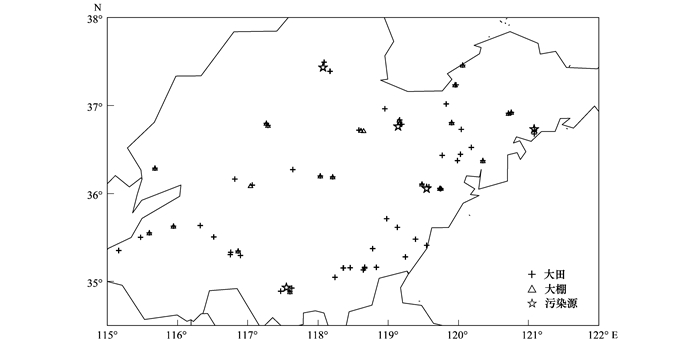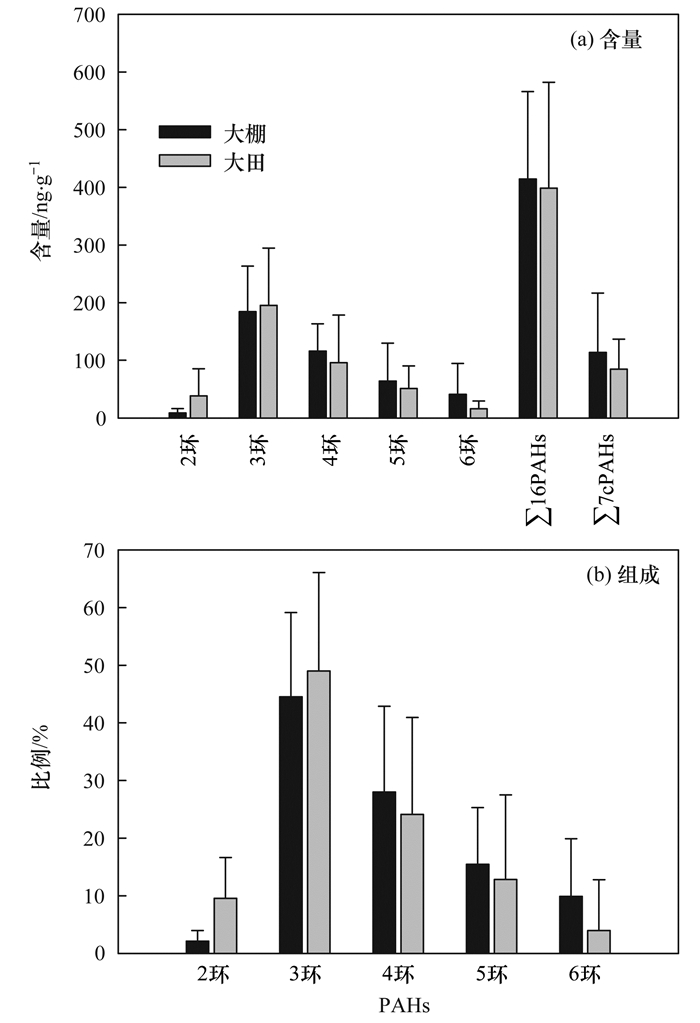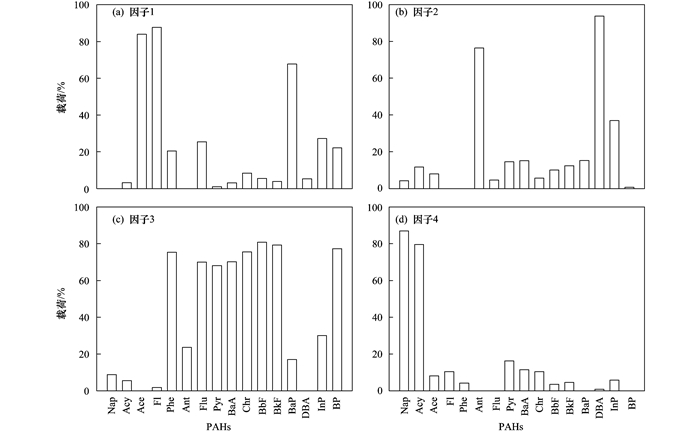2. 青岛农业大学资源与环境学院, 青岛 266109
2. College of Resources and Environment, Qingdao Agricultural University, Qingdao 266109, China
多环芳烃 (PAHs) 是一类广泛分布于环境中的有机污染物,具有持久性和强烈的致癌、致畸、致突变性,对生态环境和人体健康具有较大的威胁[1].美国环保署将16种PAHs列为优先控制污染物,我国也将7种PAHs列入中国环境优先监测黑名单.
PAHs有自然源和人为源2种来源,自然源包括森林火灾、火山喷发和植物分解等[2],对环境中PAHs的贡献非常小.人为源是近代以来环境中PAHs严重污染的主要原因,其中化石燃料和木材等的不完全燃烧和石油精炼等已经成为环境中PAHs的重要来源[3].土壤是环境中PAHs的储库,英国的研究发现,土壤中PAHs占其所有储量的90%[4],在PAHs迁移和转化过程中也起着重要的作用.
我国关于土壤中PAHs的含量组成和来源分析的研究较多,但多数研究或仅针对某一地区开展,未区分土地利用方式的差异[5~8],或仅针对某一种类型污染源,如电子回收厂、焦化厂等周边土壤进行研究[9, 10],而关注土地利用方式和污染源类型对同一地区农田土壤PAHs污染特征的影响较少.此外,在土壤中PAHs源解析研究中,采用比值法等定性方法研究的相对较多[8, 11],但定量分析农田土壤不同来源PAHs贡献率的研究较少.
山东省是我国农业大省,同时工业发达、人口密集、交通便利,是我国的经济第三大省、人口第二大省.随着工农业的发展和人类活动的增加,环境污染问题也受到关注[12, 13],但关于山东省农田土壤中PAHs的研究极为有限.此外,除大田粮食作物外,山东省是我国蔬菜大棚较为密集的地区,而这两种土地利用方式是否可能导致土壤中PAHs出现不同的研究未见报道.因此,本文以山东省农田土壤为研究对象,探究其PAHs的含量和组成特征,比较大田和大棚、点源和非点源污染等不同来源农田土壤中PAHs的含量,定量解析PAHs来源并进行风险评价,以期为该地区农田土壤中PAHs的污染风险调控提供依据.
1 材料与方法 1.1 土壤样品采集和保存2015年7月在山东省16个地级市采集农田土壤,采样布点时主要考虑土壤类型、土地利用方式、污染源类型等因素.本研究将污染源类型分为非点源污染和点源污染.非点源污染指附近没有明确的排放污染源,土壤中PAHs主要来自大气沉降.点源污染指由于工业活动集中排放废气、废水或固体废物对土壤产生的污染.本研究采集非点源污染的种植粮食作物的大田土壤样本87个和点源污染周边50~100 m处的大田土壤样本10个,点源污染工业类型包括燃煤电厂、化肥厂和化工厂等.为了比较不同土地利用方式的差异,采集蔬菜大棚土壤样本27个,并在每个蔬菜大棚附近对应采集1个大田土壤样本做对比研究.采样点分布情况见图 1,每个采样点在500 m2范围内,用不锈钢铲采集5~6处0~20 cm表层土壤,混合均匀.土壤样品经冷冻干燥、磨细,过2 mm筛,于暗处4℃贮存.

|
图 1 山东省农田土壤采样点位置示意 Fig. 1 Geographic location of sampling sites of agricultural soils from Shandongs |
PAHs的提取和测定参考Gao等[14]的方法并进行改进,取2 g土壤样品于30 mL玻璃离心管中,加入10 mL二氯甲烷,盖紧后,于超声水浴中超声萃取1 h,以4 000 r ·min-1离心10 min,收集提取液.提取过程重复两次,将提取液合并并浓缩,利用层析柱净化 (上层4 g无水硫酸钠,下层4g硅胶),用11 mL 1 :1(体积比) 的二氯甲烷和正己烷溶液洗脱.洗脱液收集至旋转蒸发瓶,40℃恒温下浓缩近干,用甲醇定容到2.0 mL,过0.22 μm孔径滤膜后待分析.
采用高效液相色谱紫外/荧光检测器串联 (HPLC/UV-FLD) 的方法检测PAHs,色谱柱为Inertsil ODS-P色谱柱 (250 mm×4.6 mm,粒径3.5 μm,孔径1 000 nm),流动相为甲醇-水,采用梯度淋洗,流速1.0 mL ·min-1,柱温40℃,进样量20 μL.紫外检测器波长为254 nm,荧光检测采用程序定时控制荧光检测波长变化,其中激发波长为265、260、290和250 nm,发射波长为420、430和500 nm.
本研究检测了美国环保署优先控制的16种PAHs,分别是萘 (Nap)、苊烯 (Acy)、苊 (Ace)、芴 (Fl)、菲 (Phe)、蒽 (Ant)、荧蒽 (Flu)、芘 (Pyr)、苯并 (a) 蒽 (BaA)、(Chr)、苯并 (b) 荧蒽 (BbF)、苯并 (k) 荧蒽 (BkF)、苯并 (a) 芘 (BaP)、二苯并 (a, h) 蒽 (DBA)、茚并 (1, 2, 3-cd) 芘 (InP)、苯并 (g, h, i) 苝 (BP).这16种PAHs中有7种属于致癌PAHs,包括:BaA、Chr、BbF、BkF、BaP、DBA和InP. PAHs标准品购于美国AccuStandard,溶剂纯度为色谱纯.
1.3 质量控制采用方法空白、基质加标和样品双平行样控制质量.每10个样品做1个空白,空白中未检出目标化合物.所有样品采用双平行样进行检测,16种PAHs的回收率为60.9%~104.2%,相对标准偏差范围为0.6%~15.8%.采用外标法进行定量,标准曲线浓度设置为5、10、20、50和100 μg ·L-1.每15个样品做1次标准曲线,用于校准仪器的稳定性. 16种PAHs的方法检出限为0.07~2 ng ·g-1.
1.4 正定矩阵因子 (PMF) 模型PMF模型属定量源解析方法,由Paatero等提出[15],此方法成功用于大气、土壤和沉积物中PAHs的源解析[16],模型原理见文献[6].本研究采用美国环保署PMF5.0模型对PAHs的污染源进行解析,模型的输入数据包括土壤中PAHs的含量数据 (C) 和含量数据的不确定度,低于检出限 (MDL) 的含量用 (1/2) MDL代替.若含量低于MDL,其不确定度为 (5/6) MDL;若含量高于MDL,其不确定度为[(MU×C)2+(MDL)2]1/2,MU为实际测量的不确定性,取10%[17].数据输入后,模型采用“Robust”模式进行计算,以消除个别极值的影响.模型的目标函数Q(E) 是模型的判据之一,公式见文献[6],只有当Q(E) 收敛时才可进一步分析,且多次运行,选取Q(E) 较小的值来继续分析. PMF主因子数目选择的主要依据是模型得到的Q(E) 与Q(E) 理论值较为接近,此外,截距、斜率、R2等重要参数也可以用来评价PMF运行的效果.
1.5 风险评估方法采用苯并 (a) 芘的毒性当量含量 (TEQBaP,ng ·g-1) 评价PAHs的生态风险,计算公式为:

|
式中,Ci是第i个PAHs的含量,ng ·g-1;TEFi为第i个PAHs的毒性当量因子,数据参考文献[18].
2 结果与讨论 2.1 PAHs含量和组成山东省农田土壤中PAHs的检出率较高,除DBA和BP外,其余PAHs的检出率均达到或超过90% (表 1). 16种PAHs总含量 (Σ16PAHs) 范围为111.5~2 744.1 ng ·g-1,均值为556.3 ng ·g-1.其中3环PAHs的含量较高,达到201.5 ng ·g-1,2环和6环PAHs的含量较低,分别为39.3 ng ·g-1和43.4 ng ·g-1. 7种致癌PAHs的总含量 (Σ7cPAHs) 范围为11.1~1 416.2 ng ·g-1,占Σ16PAHs的3%~82%,表明农田土壤中Σ7cPAHs的占比差异较大.
|
|
表 1 山东省农田土壤中PAHs的含量和检出率1) Table 1 Content and detectable ratio of individual and total PAHs in agricultural soils from Shandong province |
Maliszewska-Kordybach对土壤中16种优先控制PAHs污染程度建立了分级标准,Σ16PAHs含量 < 200 ng ·g-1为未污染、200~600 ng ·g-1为轻度污染、600~1 000 ng ·g-1为污染、 > 1 000 ng ·g-1为重度污染[19].依据该标准,山东省农田土壤中71%的样品呈轻度污染,11%和10%的样品分别呈污染和重度污染,只有8%的样品未污染.
有研究发现,我国表层土壤中PAHs含量的中位值为580 ng ·g-1 [20],略高于本研究.这可能是由于之前的研究未区分土地利用方式,且油田、化工厂、焦化厂、燃煤电厂、电子废物回收场地等污染区域的土壤样本占有较大比例.本研究主要是针对农田土壤,一般农田距离工业区相对较远,靠近点源污染的农田比例相对较低,因此为了客观反映实际,本研究采集了一部分点源污染周边的农田土壤,但样本比例相对较低,所以PAHs的中位值略低.
与国内其他地区的农田土壤相比,山东省农田土壤Σ16PAHs与吉林 (144.5~2 355 ng ·g-1)[21]、上海 (92.2~2 062.7 ng ·g-1)[22]等地接近,低于南京 (21.5~3 350 ng ·g-1)[5]、广州和深圳 (160~3 370 ng ·g-1)[23]等地,但高于大连 (181~266 ng ·g-1)[24]、黄淮平原 (15.7~1 246 ng ·g-1)[25]、汕头 (22.1~1 256.9 ng ·g-1)[26]、南昌 (75.2~422.8 ng ·g-1)[27]、慈溪 (70. 4~325.1 ng ·g-1)[28]、宜兴 (93~267 ng ·g-1)[29]、忻州 (ND~782 ng ·g-1)[30]等地.因此,就农田土壤PAHs污染而言,山东省处于中等水平.
山东省农田土壤中PAHs的组成见图 2,Ace、Fl、Flu的平均比例最高,均超过10%,其次是Acy、Phe和Nap.相比而言,InP的平均比例只有1.7%,显著低于其他PAHs (P < 0.05).此外,BkF、Ant、BaA、BbF、DBA和BP等的比例也较低.研究者发现我国主要地区表层土壤中的Phe、Flu和Pyr的比例较高[20],但不同地区组成上存在一定的差异.例如,黄淮平原农田中PAHs中比例较高的是Phe、Pyr、BP、Flu、Nap[31],北京周边农田是Flu、Pyr、Nap、Phe、BkF和BP[32],而天津农田是Nap、Phe、Flu、BkF、Pyr[33, 34].本研究与周边地区农田土壤有一定的共性,均是Flu、Phe和Nap的比例较高.

|
图内数据为平均值±SD, 上、下触须线为最大、最小值 图 2 每种PAHs占总含量的比例 Fig. 2 Relative contributions of individual PAH compounds to total PAHs |
本研究中Acy、Ace、Fl和Phe较高的贡献导致3环PAHs的比例最高,占45.6%,其次是4环和5环PAHs,分别占25.7%和14.8%,但2环和6环PAHs的比例较低,仅占8.7%和5.4%.对我国主要地区表层土壤中PAHs的分析也发现,2环和6环PAHs的比例较低,约为7%和9%[20].和周边地区比较,北京和黄淮平原农田土壤中2环PAHs的比例分别为7.6%和8.3%,6环PAHs的比例分别为7.8%和11.7%[31, 32],因此,本研究2环PAHs的比例与周边地区和我国的总体情况较为接近,6环PAHs比例略低于周边地区.
2.2 不同来源土壤中PAHs的比较不同来源的大田土壤中PAHs含量和组成见图 3,非点源污染和点源污染大田土壤中的2环PAHs含量没有显著差异 (P > 0.05),但3~6环均是点源污染大田显著高于非点源污染大田 (P < 0.05),点源污染大田的Σ16PAHs高达2035.3 ng ·g-1,其中Σ7cPAHs占53%,而非点源污染大田的平均含量只有421.9 ng ·g-1,其中Σ7cPAHs占24%,因此点源污染大田Σ16PAHs和7种致癌PAHs的比例均显著高于非点源污染大田 (P < 0.05).对我国表层土壤的研究表明,不同污染源类型对土壤PAHs含量的影响较大,我国非点源和点源污染土壤中Σ16PAHs含量的中位值分别为317.3 ng ·g-1和1 812.9 ng ·g-1 [20].相比而言,山东省非点源污染大田土壤的PAHs略高于全国平均含量,点源污染大田与全国平均含量接近.

|
图 3 非点源污染大田和点源污染大田土壤中PAHs的含量和组成 Fig. 3 Content and composition of PAHs in general field soils and field soils polluted by point sources |
组成上,非点源污染大田土壤中Nap、Acy、Ace、Fl等的比例均超过10%,因此2~3环PAHs的比例显著高于点源污染大田 (P < 0.05),而点源污染大田土壤中DBA、BaA、BkF等的比例较高,超过10%,导致点源污染大田土壤中4~6环PAHs比例显著高于非点源大田 (P < 0.05).有研究发现,土壤中PAHs的污染主要是由于点源污染产生的PAHs经大气输运所致[35].由于不同PAHs的迁移能力存在差异,低环PAHs的分子量小,主要存在于气相中,长距离迁移能力强;而高环PAHs的分子量较大,且主要存在于大气颗粒相中,长距离迁移能力弱[36],因此PAHs分子量的增加导致其在大气中迁移的能力降低[37],这可能是点源污染大田土壤中高环PAHs比例较高的原因.
蔬菜大棚土壤和邻近的大田土壤相比 (图 4),大棚中2环PAHs含量显著低于周边大田土壤 (P < 0.05),而6环显著高于大田土壤 (P < 0.05),但这两类PAHs的含量所占比例较低,含量相对较高的3~5环PAHs没有显著差异 (P > 0.05),所以Σ16PAHs和Σ7cPAHs也没有显著差异 (P > 0.05),这表明塑料大棚的遮挡并未降低大棚土壤中PAHs的总量.同时,在组成上,均是3~4环PAHs的比例较高,两者没有显著差异 (P>0.05).这可能是由于蔬菜大棚种植过程中不是全年封闭,每年有一段时间接棚通风,因此不能完全阻挡大气来源中的PAHs.而且,已有研究发现,肥料中普遍检出多种有机污染物,其中某些有机肥中的PAHs总量高达138 ng ·g-1 [38].同时,山东省农田灌溉用水中地下水灌溉占有较大比例,而山东省的地下水中也发现PAHs,其中10种PAHs总量的高值达172 μg ·L-1 [39].蔬菜大棚种植过程中单位面积的灌溉水和肥料用量均高于大田,因此,即使大棚能够部分遮挡大气来源的PAHs,但其他来源也可能导致PAHs含量与周边大田土壤没有显著差异.虽然蔬菜大棚内的温度较高,有利于PAHs的挥发,而且大棚土壤中有机质含量较高,可以为微生物提供更多的物质和能量,增强了微生物降解PAHs的能力,但有研究发现这些作用主要是针对低环PAHs[40],这可能是大棚土壤中2环PAHs的含量和组成均显著低于大田土壤的原因.

|
图 4 大棚和大棚附近大田土壤中PAHs的含量和组成 Fig. 4 Content and composition of PAHs in soil from vegetable greenhouses and field soil close to vegetable greenhouses |
不同PAHs之间的比值能够反映其来源,Ant/(Ant+Phe)、Flu/(Flu+Pyr)、BaA/(BaA+Chr)、InP/(InP+BP) 等比值的标准值和山东省农田土壤的实测值见表 2.山东省农田土壤中这4种PAHs比值的平均值分别为0.35、0.60、0.42和0.40,对比标准值可知,Flu/(Flu+Pyr)、BaA/(BaA+Chr) 反映PAHs来源为生物质和煤的燃烧,InP/(InP+ BP) 反映来源为石油燃烧源,Ant/(Ant+Phe) 反映来源为燃烧源,因此总体上4种比值均反映出山东省农田土壤中的PAHs主要来自于燃烧.
|
|
表 2 山东省农田土壤PAHs间的比值和来源判定 Table 2 Ratio between PAHs and source identification in agricultural soils from Shandong province |
采用PMF5.0模型对山东省农田土壤PAHs来源进行定量分析,经多次运行,选取4个因子时,大多数PAHs的斜率接近1, r2较大,模型拟合结果较好,4个因子能够解释原始数据所包含的信息.第1主因子在Fl、Ace、BaP有较高载荷 (图 5),研究发现Fl是炼焦排放的特征化合物[41],同时炼焦也会产生大量的Ace[42],因而第1主因子代表的是炼焦排放.第2主因子在DBA、Ant、InP上具有较高的载荷,DBA和InP是石油燃烧排放的重要化合物,而且Ant也和柴油机排放关联较大[43],因此第2主因子主要与机动车尾气排放有关,代表交通源.第3主因子BbF、BkF、BP、Phe、Chr、Flu、BaA、Pyr等具有较高的载荷,Phe、Flu、BaA、Pyr是煤炭燃烧的代表化合物[43],BbF、BkF和Chr等也和煤炭燃烧的关联较大[44],也有研究发现生物质燃烧主要产生Flu、Pyr[45],因此第3主因子代表燃煤和生物质燃烧.第四主因子在Nap和Acy上具有较高的载荷,代表石油源.因此PMF模型得到的来源贡献率依次是燃煤和生物质燃烧占42.7%,炼焦排放占22.8%,交通产生的石油燃烧占19.3%,石油污染占15.2%.

|
图 5 正定矩阵因子分解的源轮廓 Fig. 5 Source profiles obtained from PMF model |
对我国主要地区表层土壤中PAHs的研究发现,北方地区土壤中PAHs的含量一般高于南方,可能与北方冬季燃煤供暖、重工业集中有较大关系[20].山东省的工业发达,工业总产值及工业增加值居中国各省前三位,重工业发展迅速,包括石化、电力、海化、油田等.据统计年鉴显示,山东省2015年能源消费量为35363万吨 (标准煤),主要以煤炭为主,占比超过80%,此外原油占比14.9%[46],因此煤炭和油品的燃烧排放是该地区PAHs污染的重要来源.山东省内的胜利油田是我国第二大石油生产基地,多年的石油开采有可能对土壤环境造成污染,围绕油田建立的石化炼焦业也可能成为PAHs的来源.此外,尽管我国多年前就禁止农作物秸秆露天焚烧,但秸秆焚烧屡禁不止,以2015年夏、秋为例,山东省秸秆焚烧点数量位居全国第3~4位,大量的秸秆焚烧也会释放PAHs.
2.4 PAHs的风险评价非点源污染大田和蔬菜大棚土壤中16种PAHs的总TEQBaP (Σ16TEQBaP) 均值分别为40.02 ng ·g-1和40.63 ng ·g-1(表 3),两者没有显著差异 (P > 0.05),但是点源污染大田土壤中的Σ16TEQBaP高达427.61 ng ·g-1,显著高于非点源污染大田和蔬菜大棚 (P < 0.05). 7种致癌PAHs的TEQBaP(Σ7cTEQBaP) 在Σ16TEQBaP中的比例均高达95%,表明其毒性风险主要来自于7种致癌PAHs,其中贡献率较高的是BaP和DBA.在加拿大土壤环境质量标准中,土壤中的Σ16TEQBaP安全值为600 ng ·g-1,炼焦厂等点源周边土壤的Σ16TEQBaP乘以3倍系数进行评估[47].依据该标准,山东省非点源污染大田和蔬菜大棚土壤中的Σ16TEQBaP均未超标,但点源污染大田土壤Σ16TEQBaP乘以3倍系数后平均值为1 282.83 ng ·g-1,其中有90%的采样点超过了安全值,因此点源污染大田土壤具有潜在的风险.
|
|
表 3 山东省农田土壤中PAHs的毒性当量含量TEQBaP /ng ·g-1 Table 3 TEQBaP of PAHs in the agricultural soils from Shandong province/ng ·g-1 |
3 结论
(1) 山东省农田土壤中PAHs检出率较高,71%的样品中呈轻度污染,Ace、Fl、Flu的平均比例最高,InP的平均比例最低.与国内其他地区的农田土壤PAHs污染水平相比,山东省处于中等水平.
(2) 点源污染大田Σ16PAHs和7种致癌PAHs的比例均显著高于非点源污染大田,非点源污染大田2~3环PAHs的比例较高,而点源污染大田中的4~6环PAHs较高.蔬菜大棚和附近的大田土壤相比,PAHs含量没有显著差异,且均是3~4环PAHs的比例较高.
(3) Ant/(Ant+Phe)、Flu/(Flu+Pyr)、BaA/(BaA+Chr)、InP/(InP+BP) 等4种比值均反映出山东省农田土壤中的PAHs主要来自于燃烧源. PMF5.0模型表明PAHs来源的贡献率是:燃煤和生物质燃烧占42.7%,炼焦排放占22.8%,交通产生的石油燃烧占19.3%,石油污染占15.2%.
(4) 非点源污染大田和蔬菜大棚土壤中Σ16TEQBaP未超过加拿大土壤环境质量标准,但点源污染大田土壤有部分样品超标,具有潜在的风险,其风险主要来自于致癌PAHs,其中贡献率较高的是BaP和DBA.
| [1] | Lynch S M, Rebbeck T R. Bridging the gap between biologic, individual, and macroenvironmental factors in cancer:a multilevel approach[J]. Cancer Epidemiology, Biomarkers & Prevention, 2013, 22(4): 485–495. |
| [2] | Zhang Y X, Tao S, Shen H Z, et al. Inhalation exposure to ambient polycyclic aromatic hydrocarbons and lung cancer risk of Chinese population[J]. Proceedings of the National Academy of Sciences of the United States of America, 2009, 106(50): 21063–21067. DOI: 10.1073/pnas.0905756106 |
| [3] | Zhang Y X, Tao S. Global atmospheric emission inventory of polycyclic aromatic hydrocarbons (PAHs) for 2004[J]. Atmospheric Environment, 2009, 43(4): 812–819. DOI: 10.1016/j.atmosenv.2008.10.050 |
| [4] | Wild S R, Jones K C. Polynuclear aromatic hydrocarbons in the United Kingdom environment:a preliminary source inventory and budget[J]. Environmental Pollution, 1995, 88(1): 91–108. DOI: 10.1016/0269-7491(95)91052-M |
| [5] | Yin C Q, Jiang X, Yang X L, et al. Polycyclic aromatic hydrocarbons in soils in the vicinity of Nanjing, China[J]. Chemosphere, 2008, 73(3): 389–394. DOI: 10.1016/j.chemosphere.2008.05.041 |
| [6] | Wang X T, Chen L, Wang X K, et al. Occurrence, sources and health risk assessment of polycyclic aromatic hydrocarbons in urban (Pudong) and suburban soils from Shanghai in China[J]. Chemosphere, 2015, 119: 1224–1232. DOI: 10.1016/j.chemosphere.2014.10.019 |
| [7] | 杜芳芳, 杨毅, 刘敏, 等. 上海市表层土壤中多环芳烃的分布特征与源解析[J]. 中国环境科学, 2014, 34(4): 989–995. Du F F, Yang Y, Liu M, et al. Distribution and source apportionment of polycyclic aromatic hydrocarbons in surface soils in Shanghai[J]. China Environmental Science, 2014, 34(4): 989–995. |
| [8] | 罗东霞, 张淑娟, 杨瑞强. 藏东南色季拉山土壤中有机氯农药和多环芳烃的浓度分布及来源解析[J]. 环境科学, 2016, 37(7): 2745–2775. Luo D X, Zhang S J, Yang R Q. Distribution and source analysis of polycyclic aromatic hydrocarbons (PAHs) and organochlorine pesticides (OCPs) in soils from Shergyla Mountain, southeast Tibetan plateau[J]. Environmental Science, 2016, 37(7): 2745–2775. |
| [9] | Duan Y H, Shen G F, Tao S, et al. Characteristics of polycyclic aromatic hydrocarbons in agricultural soils at a typical coke production base in Shanxi, China[J]. Chemosphere, 2015, 127: 64–69. DOI: 10.1016/j.chemosphere.2014.12.075 |
| [10] | Wang Y, Tian Z J, Zhu H L, et al. Polycyclic aromatic hydrocarbons (PAHs) in soils and vegetation near an e-waste recycling site in South China:concentration, distribution, source, and risk assessment[J]. Science of the Total Environment, 2012, 439: 187–193. DOI: 10.1016/j.scitotenv.2012.08.018 |
| [11] | 朱媛媛, 田靖, 魏恩琪, 等. 天津市土壤多环芳烃污染特征、源解析和生态风险评价[J]. 环境化学, 2014, 33(2): 248–255. Zhu Y Y, Tian J, Wei E Q, et al. Characteristics, sources apportionment and ecological risks assessment of polycyclic aromatic hydrocarbons in soils of Tianjin, China[J]. Environmental Chemistry, 2014, 33(2): 248–255. |
| [12] | 戴彬, 吕建树, 战金成, 等. 山东省典型工业城市土壤重金属来源、空间分布及潜在生态风险评价[J]. 环境科学, 2015, 36(2): 507–515. Dai B, Lü J S, Zhan J C, et al. Assessment of sources, spatial distribution and ecological risk of heavy metals in soils in a typical industry-based city of Shandong province, Eastern China[J]. Environmental Science, 2015, 36(2): 507–515. |
| [13] | Chai C, Cheng H Z, Ge W, et al. Phthalic acid esters in soils from vegetable greenhouses in Shandong Peninsula, East China[J]. PLoS One, 2014, 9(4): e95701. DOI: 10.1371/journal.pone.0095701 |
| [14] | Gao Y Z, Zeng Y C, Shen Q, et al. Fractionation of polycyclic aromatic hydrocarbon residues in soils[J]. Journal of Hazardous Materials, 2009, 172(2-3): 897–903. DOI: 10.1016/j.jhazmat.2009.07.084 |
| [15] | Paatero P, Tapper U. Analysis of different modes of factor analysis as least squares fit problems[J]. Chemometrics and Intelligent Laboratory Systems, 1993, 18(2): 183–194. DOI: 10.1016/0169-7439(93)80055-M |
| [16] | 孙海峰, 张勇, 解静芳. 正定矩阵因子分解模型在环境中多环芳烃源解析方面的应用[J]. 生态毒理学报, 2015, 10(4): 25–33. Sun H F, Zhang Y, Xie J F. Applications of positive matrix factorization (PMF) for source apportionment of PAHs in the environment[J]. Asian Journal of Ecotoxicology, 2015, 10(4): 25–33. |
| [17] | 廖书林, 郎印海, 王延松, 等. 辽河口湿地表层土壤中PAHs的源解析研究[J]. 中国环境科学, 2011, 31(3): 490–497. Liao S L, Lang Y H, Wang Y S, et al. Source apportionment of polycyclic aromatic hydrocarbons (PAHs) in the topsoil of Liaohe estuarine wetlands[J]. China Environmental Science, 2011, 31(3): 490–497. |
| [18] | Suman S, Sinha A, Tarafdar A. Polycyclic aromatic hydrocarbons (PAHs) concentration levels, pattern, source identification and soil toxicity assessment in urban traffic soil of Dhanbad, India[J]. Science of the Total Environment, 2016, 545-546: 353–360. DOI: 10.1016/j.scitotenv.2015.12.061 |
| [19] | Maliszewska-Kordybach B, Smreczak B, Klimkowicz-Pawlas A. Concentrations, sources, and spatial distribution of individual polycyclic aromatic hydrocarbons (PAHs) in agricultural soils in the Eastern part of the EU:Poland as a case study[J]. Science of the Total Environment, 2009, 407(12): 3746–3753. DOI: 10.1016/j.scitotenv.2009.01.010 |
| [20] | 曹云者, 柳晓娟, 谢云峰, 等. 我国主要地区表层土壤中多环芳烃组成及含量特征分析[J]. 环境科学学报, 2012, 32(1): 197–203. Cao Y Z, Liu X J, Xie Y F, et al. Patterns of PAHs concentrations and components in surface soils of main areas in China[J]. Acta Scientiae Circumstantiae, 2012, 32(1): 197–203. |
| [21] | 陆继龙, 赵玉岩, 郝立波, 等. 吉林省中部农业土壤中PAHs的分布及风险评价[J]. 吉林大学学报 (地球科学版), 2010, 40(3): 683–688. Lu J L, Zhao Y Y, Hao L B, et al. Distribution and risk evaluation of polycyclic aromatic hydrocarbons of agricultural soil in the middle Jilin province[J]. Journal of Jilin University (Earth Science Edition), 2010, 40(3): 683–688. |
| [22] | Jiang Y F, Wang X T, Wu M H, et al. Contamination, source identification, and risk assessment of polycyclic aromatic hydrocarbons in agricultural soil of Shanghai, China[J]. Environmental Monitoring and Assessment, 2011, 183(1-4): 139–150. DOI: 10.1007/s10661-011-1913-1 |
| [23] | Cai Q Y, Mo C H, Li Y H, et al. Occurrence and assessment of polycyclic aromatic hydrocarbons in soils from vegetable fields of the Pearl River Delta, South China[J]. Chemosphere, 2007, 68(1): 159–168. DOI: 10.1016/j.chemosphere.2006.12.015 |
| [24] | Wang Z, Chen J W, Qiao X L, et al. Distribution and sources of polycyclic aromatic hydrocarbons from urban to rural soils:a case study in Dalian, China[J]. Chemosphere, 2007, 68(5): 965–971. DOI: 10.1016/j.chemosphere.2007.01.017 |
| [25] | 周玲莉, 薛南冬, 李发生, 等. 黄淮平原农田土壤中多环芳烃的分布、风险及来源[J]. 中国环境科学, 2012, 32(7): 1250–1256. Zhou L L, Xue N D, Li F S, et al. Distribution, source analysis and risk assessment of polycyclic aromatic hydrocarbons in farmland soils in Huanghuai Plain[J]. China Environmental Science, 2012, 32(7): 1250–1256. |
| [26] | Hao R, Wan H F, Song Y T, et al. Polycyclic aromatic hydrocarbons in agricultural soils of the southern Subtropics, China[J]. Pedosphere, 2007, 17(5): 673–680. DOI: 10.1016/S1002-0160(07)60081-2 |
| [27] | 樊孝俊, 刘忠马, 夏新, 等. 南昌市周边农田土壤中多环芳烃的污染特征及来源分析[J]. 中国环境监测, 2009, 25(6): 109–112. Fan X J, Liu Z M, Xia X, et al. Analysis of pollution characteristics and sources of PAHs in farmland soil around Nanchang city[J]. Environmental Monitoring in China, 2009, 25(6): 109–112. |
| [28] | 李久海, 董元华, 曹志洪, 等. 慈溪市农田表层、亚表层土壤中多环芳烃 (PAHs) 的分布特征[J]. 环境科学学报, 2007, 27(11): 1909–1914. Li J H, Dong Y H, Cao Z H, et al. Distribution of polycyclic aromatic hydrocarbons (PAHs) in the surface and subsurface soils in Cixi County[J]. Acta Scientiae Circumstantiae, 2007, 27(11): 1909–1914. |
| [29] | Ding A F. Distribution of Polycyclic aromatic hydrocarbon (PAHs) in farmland of parts of Jiangsu Province and its ecological risk[J]. Nanjing:Nanjing Agricultural University, 2007: 26–38. |
| [30] | Zhao L, Hou H, Shangguan Y X, et al. Occurrence, sources, and potential human health risks of polycyclic aromatic hydrocarbons in agricultural soils of the coal production area surrounding Xinzhou, China[J]. Ecotoxicology and Environmental Safety, 2014, 108: 120–128. DOI: 10.1016/j.ecoenv.2014.05.034 |
| [31] | Yang B, Xue N D, Zhou L L, et al. Risk assessment and sources of polycyclic aromatic hydrocarbons in agricultural soils of Huanghuai plain, China[J]. Ecotoxicology and Environmental Safety, 2012, 84: 304–310. DOI: 10.1016/j.ecoenv.2012.07.027 |
| [32] | Ma L L, Chu S G, Wang X T, et al. Polycyclic aromatic hydrocarbons in the surface soils from outskirts of Beijing, China[J]. Chemosphere, 2005, 58(10): 1355–1363. DOI: 10.1016/j.chemosphere.2004.09.083 |
| [33] | Tao S, Cui Y H, Xu F L, et al. Polycyclic aromatic hydrocarbons (PAHs) in agricultural soil and vegetables from Tianjin[J]. Science of the Total Environment, 2004, 320(1): 11–24. DOI: 10.1016/S0048-9697(03)00453-4 |
| [34] | Wang W T, Simonich S L M, Xue M, et al. Concentrations, sources and spatial distribution of polycyclic aromatic hydrocarbons in soils from Beijing, Tianjin and surrounding areas, North China[J]. Environmental Pollution, 2010, 158(5): 1245–1251. DOI: 10.1016/j.envpol.2010.01.021 |
| [35] | Kim K H, Jahan S A, Kabir E, et al. A review of airborne polycyclic aromatic hydrocarbons (PAHs) and their human health effects[J]. Environment International, 2013, 60: 71–80. DOI: 10.1016/j.envint.2013.07.019 |
| [36] | Yu X Z, Gao Y, Wu S C, et al. Distribution of polycyclic aromatic hydrocarbons in soils at Guiyu area of China, affected by recycling of electronic waste using primitive technologies[J]. Chemosphere, 2006, 65(9): 1500–1509. DOI: 10.1016/j.chemosphere.2006.04.006 |
| [37] | Melnyk A, Dettlaff A, Kuklińska K, et al. Concentration and sources of polycyclic aromatic hydrocarbons (PAHs) and polychlorinated biphenyls (PCBs) in surface soil near a municipal solid waste (MSW) landfill[J]. Science of the Total Environment, 2015, 530-531(1-2): 18–27. |
| [38] | 莫测辉, 李云辉, 蔡全英, 等. 农用肥料中有机污染物的初步检测[J]. 环境科学, 2005, 26(3): 198–202. Mo C H, Li Y H, Cai Q Y, et al. Preliminary determination of organic pollutants in agricultural fertilizers[J]. Environmental Science, 2005, 26(3): 198–202. |
| [39] | 朱恒华, 曾庆斌, 徐建国, 等. 淮河流域 (山东段) 南部平原区浅层地下水有机污染特征[J]. 地质学刊, 2014, 38(3): 511–516. Zhu H H, Zeng Q B, Xu J G, et al. On organic pollution of shallow groundwater in southern plain of Huaihe River Basin (Shandong section)[J]. Journal of Geology, 2014, 38(3): 511–516. |
| [40] | 韩晓君, 潘根兴, 李恋卿. 长期不同施肥处理下有机质含量变化对土壤中多环芳烃降解的影响--以太湖地区黄泥土长期试验为例[J]. 农业环境科学学报, 2009, 28(12): 2533–2539. Han J X, Pan G X, Li L Q. Effects of the content of organic matter on the degradation of PAHs:a case of a paddy soil under a long-term fertilization trial from the Tai Lake region, China[J]. Journal of Agro-Environment Science, 2009, 28(12): 2533–2539. |
| [41] | 刘春慧, 田福林, 陈景文, 等. 正定矩阵因子分解和非负约束因子分析用于大辽河沉积物中多环芳烃源解析的比较研究[J]. 科学通报, 2010, 55(10): 915–920. Liu C H, Tian F L, Chen J W, et al. A comparative study on source apportionment of polycyclic aromatic hydrocarbons in sediments of the Daliao River, China:positive matrix factorization and factor analysis with non-negative constraints[J]. Chinese Science Bulletin, 2010, 55(10): 915–920. DOI: 10.1007/s11434-010-0057-y |
| [42] | Wang X T, Miao Y, Zhang Y, et al. Polycyclic aromatic hydrocarbons (PAHs) in urban soils of the megacity Shanghai:occurrence, source apportionment and potential human health risk[J]. Science of the Total Environment, 2013, 447: 80–89. DOI: 10.1016/j.scitotenv.2012.12.086 |
| [43] | Wang C H, Wu S H, Zhou S L, et al. Polycyclic aromatic hydrocarbons in soils from urban to rural areas in Nanjing:concentration, source, spatial distribution, and potential human health risk[J]. Science of the Total Environment, 2015, 527-528: 375–383. DOI: 10.1016/j.scitotenv.2015.05.025 |
| [44] | Qin L, Han J, He X, et al. The emission characteristic of PAHs during coal combustion in a fluidized bed combustor[J]. Energy Sources, Part A:Recovery, Utilization, and Environmental Effects, 2014, 36(2): 212–221. DOI: 10.1080/15567036.2010.536830 |
| [45] | Ma C L, Ye S Y, Lin T, et al. Source apportionment of polycyclic aromatic hydrocarbons in soils of wetlands in the Liao River Delta, Northeast China[J]. Marine Pollution Bulletin, 2014, 80(1-2): 160–167. DOI: 10.1016/j.marpolbul.2014.01.019 |
| [46] | 山东省统计局.山东省统计年鉴-2015[EB/OL]. http://www.stats-sd.gov.cn/col/col211/index.html, 2015-10-26. |
| [47] | Canadian Council of Ministers of the Environment. Polycyclic aromatic hydrocarbons. Canadian soil quality guidelines for protection of environmental and human health. Canadian soil quality guidelines. 2010[EB/OL]. http://ceqgrcqe.ccme.ca/, 2014-01-15. |
 2017, Vol. 38
2017, Vol. 38


